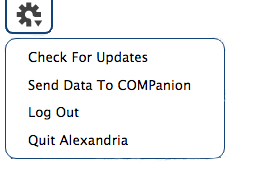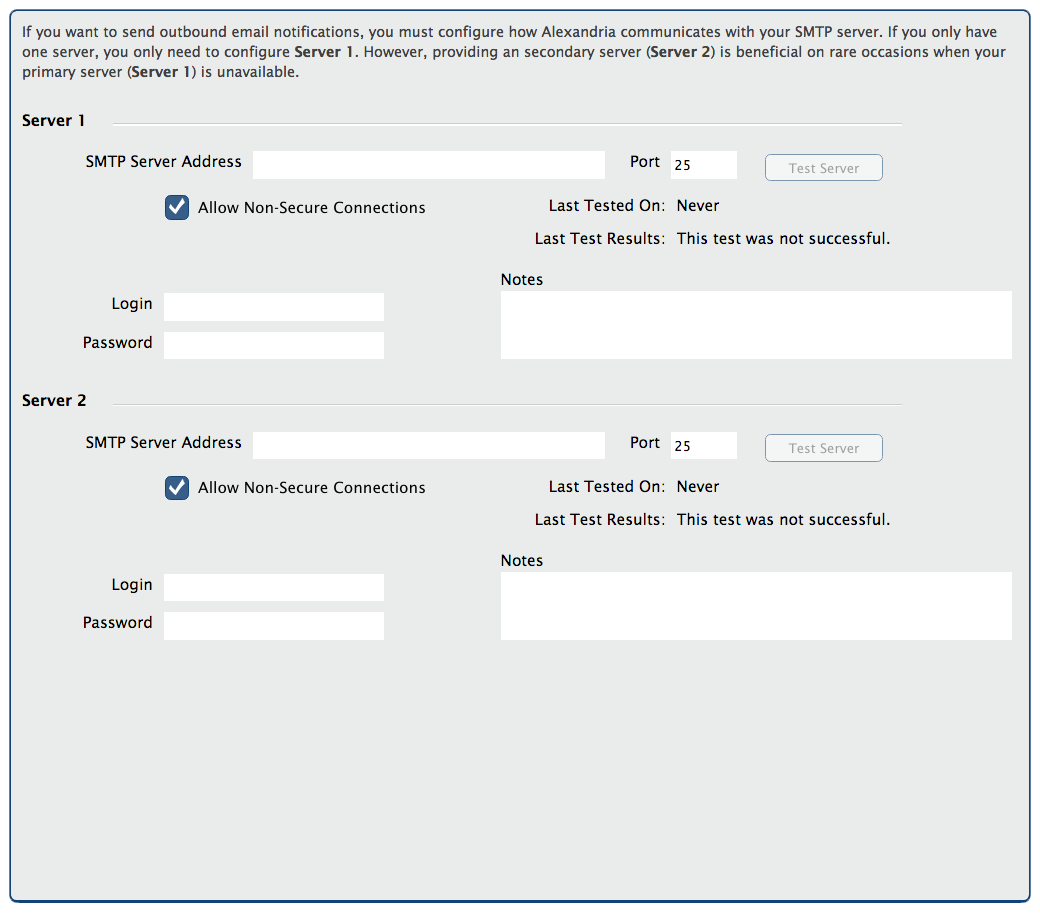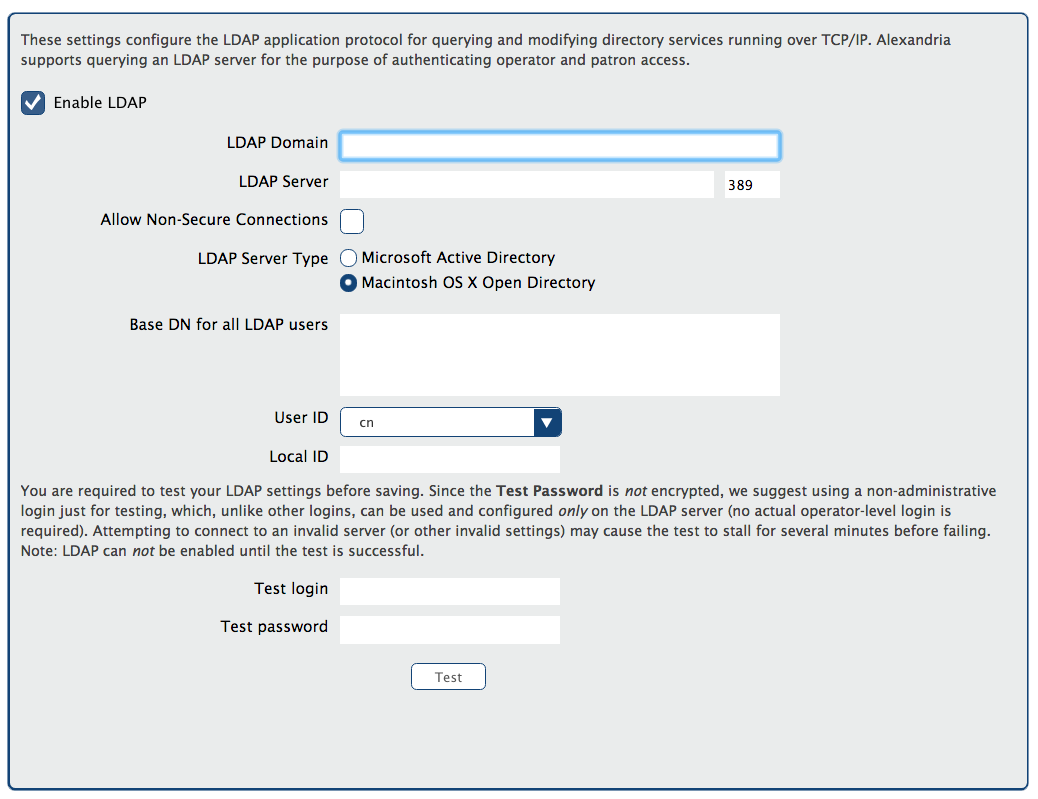What are administration settings?
The Administration settings are high-level preferences intended for network administrators, IT support departments, or operators with administrator-level permissions; in other words, they're advanced settings used to configure your main Data Station once and then be forgotten.
While every operator with the proper security permissions can access the Administration module, it contains settings that most operators won't be able to configure without help. An operator's access to these settings is governed by Alexandria's security preferences. Your library's administrator can manage these settings in Tools > Preferences > Security.
Actions Menu
- Send Data to COMPanion. If a Customer Support Representative needs your library data for troubleshooting you can easily send it to us by selecting this option and entering the Authorization Code you are provided.
Log Out. This button will log you out of Alexandria, despite if you have multiple windows open.
Quit Alexandria. This option will stop the Data Station from running and log out any active operators.
Navigation Bar
Status | These settings allow you to perform maintenance on your library catalog and update your Alexandria program. | |
| These settings allow you to designate an SMTP server to use for sending emails, such as Item Overdue Notices, to patrons and/or staff. | ||
LDAP | These settings allow you to authenticate operator and patron program access. | |
Checkpoint | If your library utilizes the Checkpoint ILS security system use these setting to enhance your SIP2 protocol. |
What does the status interface do?
It's where an operator can easily access their Alexandria registration information, perform database maintenance, run or restore from archives, and update to the latest version. It's the default interface when accessing administration settings.
Database Maintenance
You have the ability to preserve and maintain your library catalog data by utilizing the following options through the status interface.
Restore From Archive. Use this option to replace your current data folder with a previously created archive. This is useful if you need to undo a completed process such as imports or utilities.
- Archive. Selecting this button performs an immediate, manual archive of your database. During an archive, all information in the Data Station's data folder is copied into the archive directory you've configured. While the archive is running all services on the data station are temporarily disabled. We recommend running an archive before making any large-scale changes to your database, such as imports, updates, utilities, or machine upgrades.
- Restart. Selecting this button will restart the Data Station remotely. During the restart duration, Alexandria services and modules will be unavailable to all operators.
- Database Maintenance. Selecting this button will examine your database files and perform patron, item, and circulation verification routines. If database damage is detected, it's automatically fixed. While maintenance is being performed the Data Station will be inaccessible. This process can also be scheduled to perform regularly.
Send your patrons email notifications
To send email reminders, such as the Overdue Items Notice, you will need to configure how Alexandria communicates with your library's email server. Alexandria's email system is designed to potentially cope with hundreds of emails being sent (or resent) over many machines at the same time.
Email Settings
The Server 1 and Server 2 sections are used for out-bound email. Server 1 is the primary server and Server 2 can function as a back up server should server 1 fail. You only need one SMTP server to use the email functionality; for networks with a single SMTP server configure the setting in the Server 1 section.
SMTP Server 1 and 2. This is the TCP/IP or DNS address of your library's mail server. Typically, this will be “ mail.” followed by your domain name.
Port. Enter the port number that your email server uses.
Allow Non-Secure Connections. Alexandria uses Transport Layer Security (TLS) for secure web communications, when this setting is enabled the system will use non-TLS connections if it cannot make an TLS connection.
Log In. Enter the login for your email server.
Password. Enter the password for your email server.
Test Server. Test the SMTP Server settings by sending a test email. This email is sent to the email address listed in the Sites module.
Last Tested On. This field displays the last date/time that the server test was performed.
Last Test Results. This field displays whether the test was successful or not.
Setting Up Your SMTP Server
Before setting up your SMTP server you will need to enter a valid email address in the sites management settings of Alexandria.
- Click on Tools to the left of your Circulation window.
- Click on Sites under the Management header.
- Enter the name of your site contact (typically this will be the District or Library Administrator of Alexandria), their title, their email and their phone/fax numbers.
- Click Save in the upper right corner.
Once you have saved this information you are ready to set up the SMTP server.
- Access Tools > Administration.
- Click Email on the left.
- Enter your SMTP server address and port in the available fields.
- Check the box if you want to allow non-secure connections. (optional)
- Enter the login and password for your SMTP server.
- Click Save in the upper-right corner of the window.
- Repeat steps 1-6 if you want to configure a back up server for Server 2.
Using Gmail as your SMTP Server
A Gmail account can be used as a portable SMTP server if your library's network does not already have one. Before you configure Alexandria to use Gmail, you will need to set your Gmail preferences to Allow Less Secure Apps.
- Access Tools > Administration.
- Click Email on the left.
- Enter smtp.gmail.com as the SMTP Server Address.
- Enter 587 as the port.
- Check the box if you want to allow non-secure connections. (optional)
- Enter the login and password for your Gmail account.
- Click Save in the upper-right corner of the window.
- Click Test Server to ensure the Gmail account is acting as a server.
- Repeat steps 1-8 if you want to configure a back up server for Server 2.
LDAP supports user-authentication for open or active directories
Lightweight Directory Access Protocol (LDAP) is an application protocol for querying and modifying directory services running over TCP/IP. Alexandria supports user-authentication using existing log-on credentials maintained on a separate directory server. With LDAP enabled, administrators can now choose to manage these credentials on a central LDAP server as these credentials may change frequently and often need to be standardized across many different systems. A permanent record must exist locally in the Alexandria database for all patrons and operators that use the system however their log-on credentials can be managed outside of Alexandria on your LDAP server directly.
Important
Operator usernames and barcodes must be unique. Please make sure your Alexandria patrons do not have the same barcode as an operator.
How does it work?
The COMPanion software will send the credentials the user enters in any log-in dialog to the specified LDAP server in the form of a BIND. If the BIND is successful, the software will locate the user's record within the local database by searching the information returned in the specified Local ID field from the LDAP server. Once the record is found, the user will be logged in. Alexandria will test the credentials against the local data base if the login attempt fails.
Configuring LDAP Settings
If you are a Centralized Catalog these setting will apply to all sites within your controller.
- Navigate to Tools > Administration > LDAP.
- Check Enable LDAP.
- Enter the name of you LDAP domain, i.e. “yourdomain.com” in the LDAP Domain field. The domain name is used in conjunction with sAMAccountName to produce a complete userPrincipalName.
- Enter the full name of the LDAP server, i.e. “ldap.yourdomain.com” in the LDAP Server field. This will be the host address of the LDAP server for network communication.
Check Allow Non-Secure Connections if you would like Alexandria to use non-TLS connections when it cannot make an TLS connection. (optional)
- Enter a DN that matches all the users, i.e. “cn=users,dc=ldap,dc=yourdomain,dc=com” in the Base DN for all LDAP users field. Multiple Base DNs can be specified if separated by semicolons i.e. “cn=staff,ou=COMPanion,dc=demo,dc=goalexandria,dc=com;cn=student,ou=COMPanion,dc=demo,dc=goalexandria,dc=com”.
- Select the User ID from the dropdown menu. This is the LDAP login name; for an Open Directory, this is typically uid (i.e. “uid=yourlogin"). For an Active Directory this is typically cn, sAMAccountName, or userPrincipalName.
- Enter the LDAP database username that contains the patron username or patron barcode in Alexandria in the Local ID field. This must be one of the users' LDAP attributes; common attribute names include uid, uidNumber, givenName, cn, and others.
- Enter the Test Login.
- Enter the password for the test login in Test Password field.
- Click Test. This button initiates an attempt to log into the LDAP server using the settings and credentials you've entered.
- Click Save in the upper right corner of the window.
More testing on LDAP
If configured correctly, your users should be able to log into Alexandria using the same login credentials as configured on the directory server for their account. However, sometimes difficulty arises. In these cases, verify your preferences settings and test whether the Base DN and other information you have specified is accurate to your configuration.
We have found that Active Directory configurations seem to prefer binds using the user's CN while OSXs Open Directory prefers the uid (i.e. user identification). The use of ldapsearch tool is suggested. Alternately, ldp.exe can be utilized for testing in a Windows environment.
Non Secure Connection Testing
The -ZZ parameter requires successful connection utilizing StartTLS over port 389. If you have selected to Allow Non-Secure Connections, omit this in your testing with ldapsearch as well.





